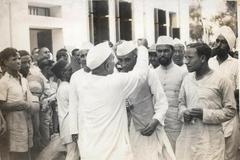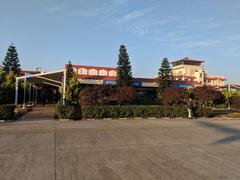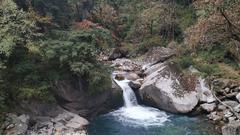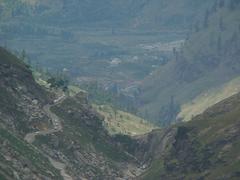National Highway 303 Himachal Pradesh Visiting Guide: Tickets and Travel Tips
Date: 14/06/2025
Introduction to National Highway 303 and Its Significance
National Highway 303 (NH 303) in Himachal Pradesh, India, is a pivotal corridor that weaves through the state’s lush landscapes, rich cultural tapestry, and progressive development. Stretching approximately 70–90 kilometers (depending on route context), NH 303 connects important districts such as Kangra and Hamirpur, and also links the scenic Mandi–Manali stretch. Winding through the lower Himalayan foothills and the heart of the Kullu Valley, this highway integrates towns and villages like Nagrota Bagwan, Nadaun, Mandi, Kullu, Naggar, and Manali.
Beyond facilitating regional connectivity, NH 303 provides access to significant historical sites like Kangra Fort, architectural wonders such as the Masroor Rock Cut Temples, and vibrant cultural events including Kullu Dussehra and the commemoration of the Battle of Nadaun. This route is emblematic of Himachal Pradesh’s commitment to improving infrastructure in challenging mountainous terrain—leading to enhanced accessibility, reduced travel times, and robust socio-economic growth through increased tourism, agriculture, and local industries.
NH 303 is well-maintained with reliable amenities, fuel stations, eateries, and easy reach to attractions like the Great Himalayan National Park and Solang Valley. The highway also intersects with major arteries such as NH 3 and NH 88, offering flexibility for travelers venturing across Himachal Pradesh.
This comprehensive guide covers NH 303’s route, history, cultural context, practical travel tips, and sustainable tourism considerations. Whether you are a history buff, nature lover, or adventure enthusiast, NH 303 offers a memorable passage through Himachal Pradesh’s storied heritage and stunning vistas. For the latest information, refer to the National Highways Authority of India, Himachal Pradesh Public Works Department, and Himachal Tourism.
Table of Contents
- Introduction
- Early Development of National Highways in Himachal Pradesh
- NH 303 Route and Geographical Context
- Historical Significance of Regions Along NH 303
- Regional Connectivity and Development
- Cultural and Religious Importance
- Travel Tips and Visitor Information
- Evolution and Modernization of NH 303
- Socio-Economic Impact
- Preservation and Sustainable Development
- Frequently Asked Questions (FAQs)
- Conclusion
Early Development of National Highways in Himachal Pradesh
The establishment of national highways in Himachal Pradesh is rooted in the National Highways Act of 1956, which laid the foundation for state investment in highway construction and maintenance (Government of India). The National Highways Authority of India (NHAI), created in 1988, has since managed the expansion and upkeep of these essential routes.
Initially, Himachal Pradesh’s highway network was sparse due to the formidable terrain. By 2020, however, the state’s national highways spanned nearly 2,600 kilometers, a significant leap from previous decades (Himachal Pradesh PWD). NH 303 has been instrumental in connecting remote areas, supporting commerce, and promoting tourism.
NH 303 Route and Geographical Context
NH 303 links Nagrota Bagwan in Kangra district to Nadaun in Hamirpur district, running through the lower Himalayan foothills (NHAI). This corridor is not only a connector within the state’s highway system but also a lifeline for residents and businesses in smaller towns and villages.
The highway’s integration with NH 3 and NH 88 enhances travel flexibility, granting easy access to major destinations like Mandi, Dharamshala, and Shimla.
Historical Significance of Regions Along NH 303
Kangra and Nagrota Bagwan
Kangra, the starting point of NH 303, is renowned for landmarks such as the venerable Kangra Fort and the Masroor Rock Cut Temples. Nagrota Bagwan, a commercial and educational hub, is also famous for Kangra miniature paintings and its strategic placement on ancient trade routes (Himachal Tourism).
Nadaun and Hamirpur
Nadaun, where NH 303 culminates, is noted for the Battle of Nadaun (1691), in which Guru Gobind Singh led Sikh forces to victory. Its scenic location along the Beas River and historic sites like the Gurudwara Sahib draw visitors interested in Sikh and Rajput history. Hamirpur district is rooted in the legacy of the Katoch dynasty and is recognized for its tradition of military service (Hamirpur District Official).
Regional Connectivity and Development
NH 303 has transformed connectivity between Kangra and Hamirpur districts. Previously, travel was arduous, particularly during monsoon-induced landslides. The highway has not only shortened travel times but also opened up markets for agricultural products such as tea, vegetables, and fruit (Himachal Pradesh PWD).
Additionally, NH 303 has improved access to educational and healthcare institutions, thereby uplifting the socio-economic status of local communities.
Cultural and Religious Importance Along NH 303
Dubbed “Land of the Gods,” areas along NH 303 are rich in religious heritage. Important sites include the Brajeshwari Devi Temple and Chamunda Devi Temple in Kangra and the Gurudwara Sahib in Nadaun.
Festivals such as Shivratri, Baisakhi, and local fairs are celebrated with fervor along the route, fostering community unity and attracting tourists (Municipal Corporation Mandi).
Travel Tips and Visitor Information
Best Time to Travel
Optimal periods are March–June and September–November, when the climate is pleasant and the risk of landslides is low. Monsoon season (July–August) can lead to road disruptions.
Accessibility and Amenities
NH 303 is well-maintained, with facilities like fuel stations, roadside eateries, and rest stops. Mobile coverage is mostly reliable but may be limited in remote stretches.
Key Sightseeing Spots
- Kangra Fort: Historic citadel with panoramic views.
- Masroor Rock Cut Temples: Intricately carved monolithic temples.
- Nagrota Bagwan: Renowned for tea gardens and bustling markets.
- Nadaun: Picturesque riverside town with historic sites.
Travelers can sample local cuisine, buy handicrafts, and participate in cultural festivals along the way.
Tickets and Permits
There are no highway tolls or special permits required for NH 303. However, travelers should carry valid identification and vehicle documents.
Evolution and Modernization of NH 303
NH 303’s modernization includes advanced engineering such as bridges and retaining walls to ensure year-round transit. The 2010 highway renumbering classified NH 303 as a north-south route, enhancing signage and navigation (Ministry of Road Transport and Highways). Ongoing upgrades by the Himachal Pradesh PWD and NHAI focus on safety, road widening, and regular maintenance (HP PWD).
Socio-Economic Impact
The highway has bolstered local economies by improving market access, fostering small businesses, and promoting tourism. It has also reduced rural outmigration by creating job opportunities, especially in agriculture (notably tea cultivation), handicrafts, and hospitality.
Preservation and Sustainable Development
Balancing infrastructure growth with the preservation of cultural and natural heritage is a priority. Sustainable tourism initiatives along NH 303 encourage responsible travel and the protection of historical and ecological sites.
Frequently Asked Questions (FAQs)
Q1: What is the length of NH 303?
A1: Approximately 70 kilometers between Nagrota Bagwan and Nadaun.
Q2: Are there tolls on NH 303?
A2: No, there are currently no tolls on this highway.
Q3: What is the best time to travel?
A3: March–June and September–November offer favorable weather.
Q4: What amenities are available?
A4: Fuel stations, eateries, and rest stops are regularly available.
Q5: Are there notable historical sites?
A5: Yes—Kangra Fort, Masroor Rock Cut Temples, and Gurudwara Sahib in Nadaun.
NH 303 Travel Guide: Mandi to Manali Route
NH 303 is also celebrated for its Mandi–Manali stretch—a 90 km scenic adventure through the Kullu Valley. This route is dotted with ancient temples, engineering marvels, adventure opportunities, and cultural festivals.
Key Stops and Attractions
- Mandi: “Varanasi of the Hills,” with Bhutnath Temple (6 AM–8 PM, free entry) and Rewalsar Lake.
- Pandoh: Home to the Pandoh Dam, important for hydropower.
- Aut: Gateway to Tirthan Valley and the Great Himalayan National Park (GHNP); GHNP (8 AM–5 PM, INR 50/250).
- Kullu: Administrative hub, famous for Kullu Dussehra and Raghunath Temple.
- Naggar: Features Naggar Castle (9 AM–6 PM, INR 30) and Nicholas Roerich Art Gallery (9 AM–5 PM, INR 50).
- Manali: Popular destination with Hadimba Devi Temple, Vashisht Hot Springs, Solang Valley, and Old Manali cafes.
Adventure and Outdoor Activities
- Trekking, paragliding, skiing, snowboarding, camping, and fishing are popular across the route. Solang Valley is a hub for adventure sports.
Road Conditions and Accessibility
- Roads are generally well-kept but can be affected by landslides during monsoon (July–September).
- Peak traffic occurs in May–June and October.
- Public transport includes HRTC buses and private taxis; nearest airport is Bhuntar (10 km from Kullu).
Side Trips
- Tirthan Valley, Kasol, Malana, and Rohtang Pass are all accessible for those seeking additional adventure.
Responsible Travel Tips
- Minimize plastic use and dispose of waste properly.
- Respect customs at religious and cultural sites.
- Choose eco-friendly accommodations where possible.
Viceregal Lodge Shimla: A Highlight Near NH 303
The Viceregal Lodge in Shimla, also known as Rashtrapati Niwas, is a Jacobethan-style monument built as the British Viceroy’s summer residence. Now housing the Indian Institute of Advanced Study, it’s a must-visit for history buffs.
Visitor Information
- Hours: 9:30 AM–5:00 PM (closed Mondays/public holidays)
- Tickets: INR 20 (Indian citizens), INR 200 (foreign nationals), free for children under 15
- Access: 5 km from Shimla city center, reachable via NH 303 and local transport
- Tips: Arrive early during peak seasons; guided tours recommended
Nearby Attractions
- Jakhoo Temple, The Ridge, Christ Church
Accessibility
- Partial wheelchair accessibility; contact ahead for assistance
Responsible Tourism
- Respect site guidelines and support local artisans
Cultural Heritage and Environmental Insights Along NH 303
Traveling NH 303 offers immersion in Himachali traditions—temples, festivals, folk dances (like Nati), and vibrant markets. The region is ecologically sensitive, traversing areas like the Great Himalayan National Park and the Shiwalik hills.
Sustainability Tips
- Carry reusable bottles and avoid single-use plastics
- Stay on marked trails; respect wildlife
- Support community-led eco-tourism initiatives
Summary and Visitor Recommendations
NH 303 is not just a highway—it is a gateway connecting history, culture, nature, and economic vitality in Himachal Pradesh. From the ancient Kangra Fort to the lively festivals and breathtaking valleys, this route offers something for every traveler. The best time to visit is March–June and September–November, with ample amenities and no tolls.
For real-time updates and more travel resources, download the Audiala app and check official websites such as the Himachal Pradesh Public Works Department, National Highways Authority of India, and Himachal Tourism. Embark on NH 303 to experience the enduring legacy and vibrant landscapes of Himachal Pradesh.
Sources and Further Reading
- NH 303 in Himachal Pradesh: Route, Historical Significance, and Regional Connectivity, 2025, Himachal Pradesh Public Works Department
- NH 303 Travel Guide: Visiting Hours, Attractions & Tips for the Mandi to Manali Route, 2025, Himachal Tourism
- Visiting the Viceregal Lodge Shimla: Hours, Tickets, and Visitor Guide, 2025, Indian Institute of Advanced Study
- Exploring Cultural Heritage and Natural Beauty Along National Highway 303 in Himachal Pradesh, 2025, Himachal Pradesh Environment Department
- National Highways Authority of India, 2025
- Ministry of Road Transport and Highways, Government of India, 2025
- Himachal Pradesh State Disaster Management Authority, 2025



